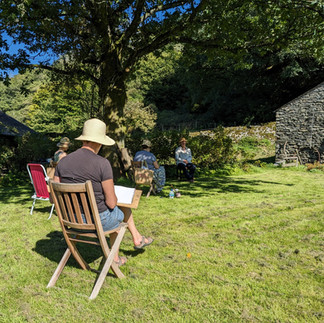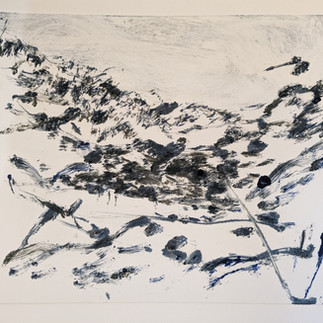Looking at Drawings
- LS

- May 27, 2024
- 3 min read
Bruegel to Rubens - Great Flemish Drawings at The Ashmolean, Oxford
I was recently lucky enough to see the wonderful and much praised exhibition of drawings at The Ashmolean Museum in Oxford. A stunning show of 120 sixteenth and seventeenth century South Netherlandish drawings drawn largely from the Ashmolean's own collection and Antwerp's Museum Plantin-Moretus.
Vasari (1511-1574) considered drawing as the 'father' or 'gateway' of all other art forms, and the necessary first step to becoming an artist, but in this show drawing becomes the gateway to the eyes and minds of artists from four centuries ago. Looking closely at a drawing, deciphering which marks were made first, sensing the speed of the artist's hand or the meticulousness of his or her observation, gives you a feeling of intimacy with the artist not possible in more sustained and 'finished' works of art. Looking at drawings (even better -making drawings of drawings!) allows you to see with the eyes of the artist and understand their process. It can also teach you so much about your own drawing.
One of the most fascinating aspects of the show was seeing the freedom with which artists used their media, combining chalks, inks, watercolour and gouache all in one drawing, moving fluently from an initial sketch in chalk or charcoal to dip pens, to brushes, according to their intentions. Sometimes a sheet of paper became too small for the image and extra strips were added to the edges to enlarge it.

In this drawing by Jordaens your sense of witnessing the artist's thinking and fluency is profound as your eye traces the faint initial chalk drawing mapping out the composition, the additional, sketchy but more secure drawing in ink with a brush, the tonal ink washes to add form and depth, the watercolour and opaque gouache to indicate colour choices and light, the additional pieces of paper added to each side, as the composition became too cramped. Close looking reveals the spontaneous iterative process of drawing which in turn reveals Jordaen's thoughts and constant visual judgements as he worked to produce a satisfactory preparatory study for a subsequent painting.
I often get asked about paper - what is best to use - and it was fascinating to notice the care with which paper was chosen and prepared. Obviously expensive, and more robust, artists were careful to use it judiciously as well as to consider it's colour and surface. Blue paper, dyed with indigo, which provided a mid tone support, was popular and allowed for the draughtsman to work from this mid tone into the darks and lights. Other papers were prepared with a mid tone wash, or a chalky surface. I confess to a particular interest in paper as one of my sons makes handmade paper at The Paper Foundation , including coloured papers for artists, of which the blue seems to be so popular they can hardly keep up with demand!

In this drawing the unknown artist has used black and white chalk on a blue laid paper. Rapid chalk hatching and highlights conveys the landscape with the lightest of touches, the blue grey paper providing the unifying tone which would have been hard to achieve if the paper were white.

In this example the paper has been given a grey ink wash before the drawing with charcoal and chalk was added. Both these drawings, with their swift gestural marks and deft description of the landscape takes you straight back 400 years as you look over the shoulder of a sixteenth century artist as he or she makes rapid judgements about tone, structure, space and form.
Looking at drawings is always an inspiration, even in books, but to see first hand such a collection, so rarely displayed due to their fragility, was a treat and an inspiration.
All our courses at Long House Studios start with drawing. As Vasari suggested - it is the gateway to all the other arts - and it is a very immediate and natural way to start a few days of intensive art making. Just as the artists of the sixteenth century used and combined all the media available to them, and worked both from direct observation, memory and imagination, we encourage you to come and explore and exploit media and to experiment with different ways to approach making work. We look at artists' work, discuss it, analyse it, learn from it, and above all, have fun!














Comments